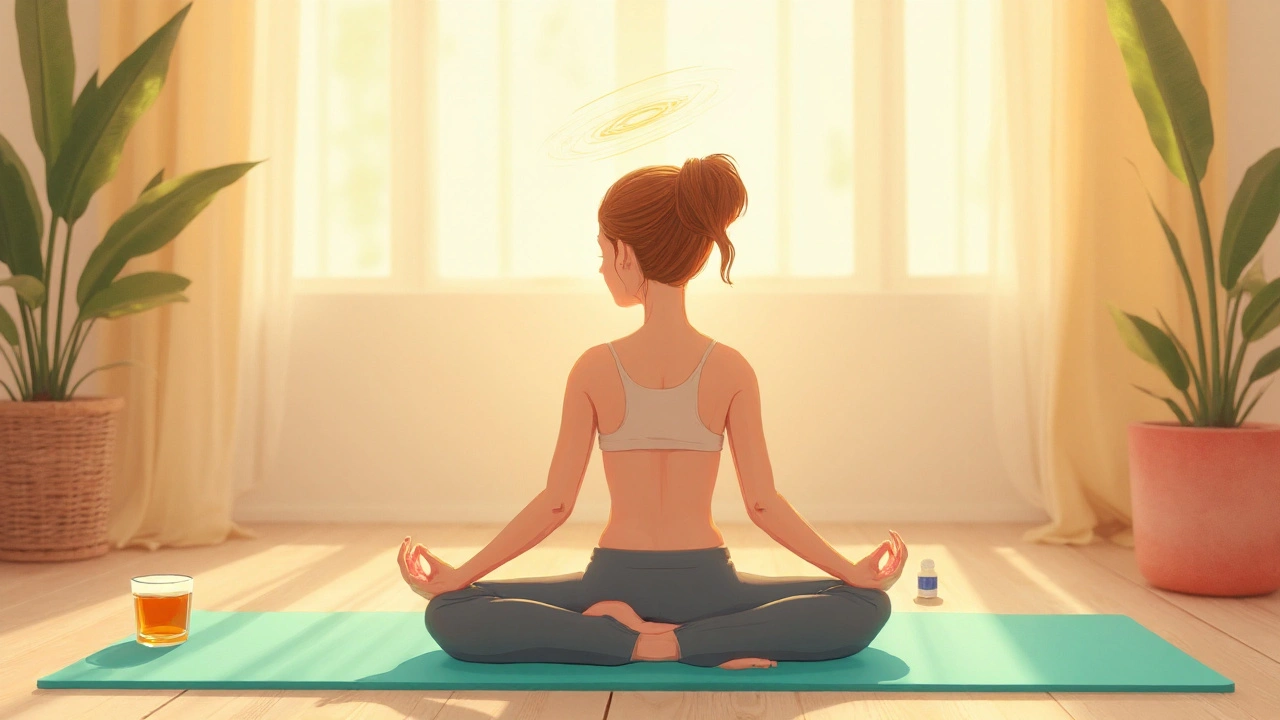Understanding Motion Sickness & Dizziness: Science, Causes, and Relief
Motion sickness is a physiological response to conflicting sensory signals, typically causing nausea, sweating, and disorientation. Most people experience it when traveling by car, boat, or plane, but it can also arise from virtual reality or even reading in a moving vehicle. Understanding why the brain throws a fit helps you pick the right coping tools and stop the queasy loop before it starts.
What Is Motion Sickness and Dizziness?
While dizziness is a broader term that covers feeling light‑headed, unsteady, or spinning, motion sickness is a specific form triggered by sensory mismatch. Dizziness can stem from low blood pressure, dehydration, or inner‑ear infections, whereas motion sickness is rooted in how the brain integrates inputs from the vestibular system, eyes, and proprioception.
How the Vestibular System Works
The vestibular system is a set of fluid‑filled canals inside the inner ear. Tiny crystals shift as you move, bending hair cells that send signals about angular acceleration to the brain. This system tells you whether you’re tilting, spinning, or staying still.
When the inner ear reports a turn but the visual system sees a stable horizon, the brain receives contradictory data. The cerebellum tries to reconcile the mismatch, and when it can’t, the autonomic nervous system kicks in, producing nausea, sweating, and pallor.
Sensory Conflict and Why It Triggers Nausea
The dominant theory, sensory conflict theory, posits that any disparity between expected and actual sensory input forces the brain into a “poison” alert mode. Historically, such conflicts could indicate neurotoxins, so the body reacts by inducing vomiting to expel the perceived poison.
Research from the University of Oxford (2023) shows that neuroimaging detects heightened activity in the insular cortex during conflict, a region linked to nausea perception. The same study found that the severity of symptoms correlates with the magnitude of mismatch measured by head‑mounted accelerometers.
Physiological Pathways: Brain and Autonomic Responses
After the cerebellum flags a mismatch, signals travel to the autonomic nervous system. This system controls heart rate, digestion, and sweating. Parasympathetic output slows the gut, while sympathetic activation raises heart rate and triggers sweating-classic signs of motion sickness.
The vagus nerve also plays a role. When overstimulated, it can cause the feeling of “the room spinning” known as vertigo. This explains why some people experience both motion sickness and severe dizziness after a short boat ride.

Common Triggers and Real‑World Examples
- Car rides with lots of winding roads - the inner ear senses constant turns while the eyes see a relatively stable road.
- Sea travel - the rolling of waves creates complex, multi‑axis motion.
- Aviation - rapid altitude changes and turbulence introduce vertical accelerations not matched by visual cues.
- Virtual reality - the headset moves the visual field without corresponding vestibular input.
Even reading a smartphone while on a bus can provoke symptoms because the eyes focus on a static screen while the vestibular system registers motion.
Treatment Options: Medications and Natural Remedies
Pharmacological relief usually targets histamine receptors or muscarinic pathways. The two most prescribed options are antihistamines (e.g., meclizine) and scopolamine patches.
| Attribute | Antihistamine (Meclizine) | Scopolamine Patch |
|---|---|---|
| Mechanism | Blocks H1 histamine receptors | Blocks muscarinic M1 receptors |
| Onset | 30-60 minutes | 2-4 hours |
| Duration | 6-8 hours | Up to 72 hours |
| Common Side Effects | Drowsiness, dry mouth | Blurred vision, drowsiness |
For those preferring a non‑drug route, ginger has shown modest efficacy. A 2022 double‑blind trial reported a 25% reduction in nausea scores after 500mg of ginger extract taken before travel. Other natural aids include peppermint oil and acupressure wristbands, which may reduce vestibular overstimulation by stimulating the median nerve.
Prevention Tips and Lifestyle Strategies
- Look at the horizon or a fixed point outside the vehicle to align visual cues with vestibular input.
- Sit in the middle of a car or over the wings of an aircraft where motion is less pronounced.
- Avoid heavy meals, alcohol, or strong odors before travel; these can amplify autonomic responses.
- Practice controlled breathing - slow inhalations through the nose, exhalations through the mouth - to calm the vagus nerve.
- Gradual exposure: short, frequent trips help the brain adapt, a process known as habituation.
Related Concepts and Emerging Research
Beyond the classic theories, researchers are exploring postural instability theory, which argues that the inability to maintain balance is the primary driver of motion sickness. Wearable inertial sensors are being used to quantify instability in real time, paving the way for personalized feedback apps.
Another frontier is the use of virtual reality for desensitization. Controlled VR environments can simulate motion while gradually increasing intensity, helping users build tolerance without actual travel.
Finally, genetic studies hint at a hereditary component: variations in the HTR3A gene (serotonin receptor) may predict susceptibility, suggesting future personalized prophylaxis.

Frequently Asked Questions
Why do I feel sick in a car but not on a train?
Cars usually have more rapid turns and acceleration changes, creating a stronger mismatch between the vestibular and visual systems. Trains move on relatively straight tracks with smoother acceleration, so the brain receives more consistent signals.
Can motion sickness be a sign of a serious health problem?
Occasional motion sickness is normal, but persistent dizziness or nausea without a clear trigger may indicate inner‑ear disorders, migraines, or cardiovascular issues. If symptoms last more than a few weeks, see a healthcare professional.
How long does it take for the body to adapt to motion?
Adaptation, or habituation, typically requires repeated exposure over 5‑10 short sessions. Some people feel relief after just a few days, while others need weeks of gradual exposure.
Are there any long‑term risks of using antihistamines for motion sickness?
Occasional use is safe for most adults. Chronic daily use may lead to tolerance, drowsiness, or anticholinergic side effects such as dry mouth and blurred vision. Always follow dosage guidelines and discuss prolonged use with a doctor.
Can ginger really help with motion sickness?
Clinical trials have shown ginger can reduce nausea intensity by about 20‑30% when taken 30 minutes before travel. It works by modulating gastrointestinal receptors and has a low side‑effect profile, making it a popular natural option.
Is there a way to predict who will get motion sick?
Family history is a strong predictor; up to 60% of sufferers report a parent with similar issues. Ongoing research into genetic markers like HTR3A suggests a future where a simple DNA test could estimate risk.





17 Comments
Earl Hutchins
September 25 2025Motion sickness is basically your brain getting confused, so the simplest fix is to line up your senses. Try to sit where the motion is least – middle seat in a car or over the wings on a plane. Keep your eyes on a stable horizon; that alone cuts the conflict in half. If you need a quick drug, meclizine works in about half an hour, but it can make you drowsy. For a natural route, ginger chewables are decent and won’t crash your day. Hydration and light meals also keep the autonomic system calm.
Karen McCormack
September 29 2025One might say the vestibular orchestra and the visual choir are engaged in a tragic opera whenever they fall out of sync, and the nausea is the audience’s disapproving roar. This sensory dissonance is not merely a glitch; it’s an evolutionary reminder that our ancestors needed to expel toxins before they could wander further. In the modern world, the same script plays out on a bus, a boat, or a VR headset, yet the chorus is artificially amplified. By re‑training the brain through graded exposure, we essentially rewrite the libretto, turning panic into poise. Consider the horizon as a metaphorical line of reason – fix your gaze and let the inner ear catch up.
Nymia Jones
October 2 2025It must be noted that the very agencies which profit from pharmaceuticals have engineered our very perception of motion sickness to keep us dependent on their patented antihistamines. The data from Oxford, while impressive, conveniently omits the fact that the insular cortex activation could be a byproduct of covert neuro‑stimulation experiments. One should therefore approach any “natural remedy” with caution, as many are co‑opted by the same corporate interests. In short, the narrative presented in popular health articles is a controlled illusion, and the true path to relief lies beyond their sanctioned protocols.
Tony Bayard
October 6 2025Picture this: you’re on a ferry, the sea tossing you like a rag doll, and your stomach does a slap‑dance to an unheard drumbeat. That’s the brain’s panic mode kicking in, shouting “toxic!” at the slightest wobble. I’ve felt it myself, and the worst part isn’t the nausea – it’s the helpless feeling of being at the mercy of invisible forces. The good news? You can wrestle back control by syncing sight and motion, just like a dancer matching steps to music. Give the horizon a stare, breathe slow, and let the inner ear know you’re still the master of the stage.
Jay Crowley
October 9 2025Meclizine works fast; ginger is a decent backup.
sharon rider
October 13 2025From a cross‑cultural standpoint, many societies have long used aromatic herbs, such as ginger and peppermint, to calm the queasy gut during travel. This suggests that the concept of “balancing” sensory input is not new, merely reframed in modern neuro‑science. By honoring these traditions alongside evidence‑based methods, we create a more holistic approach to motion intolerance.
swapnil gedam
October 16 2025What’s interesting is that wearable inertial sensors can now give real‑time feedback on how much your body is swaying, allowing apps to suggest when to look out the window or take a deep breath. Some developers are already integrating this data into VR games to gradually increase motion intensity, which helps users build tolerance without actually stepping onto a boat. So, the tech world is literally giving us a cheat‑code for the vestibular system.
Michael Vincenzi
October 19 2025Honestly, the simplest trick that saved me on every road trip was to pick the front passenger seat and keep a playlist of mellow tunes. The music masks the internal rumble and the view of the road gives your eyes the steady reference they crave. Plus, a water bottle within arm’s reach keeps dehydration at bay, which is a silent agitator for nausea.
Courage Nguluvhe
October 23 2025From a neuro‑physiological perspective, the vestibulo‑ocular reflex (VOR) desynchronization is the principal driver of the emetic cascade observed in motion‑induced sickness. By employing proprioceptive anchoring techniques-such as isometric handgrip-one can attenuate the VOR misalignment and thereby modulate the autonomic output. In lay terms, “hold on tight” isn’t just advice; it’s a micro‑stimulus to the somatosensory pathway that stabilizes the entire feedback loop.
Oliver Bishop
October 26 2025Just stare at the horizon, works every time.
Alissa DeRouchie
October 30 2025So you think ginger is the miracle cure? Please. I’ve tried it on a boat and the only thing it cured was my patience for these “natural” myths that get recycled like bad memes
Emma Howard
November 2 2025Love the practical tips! Keep those horizon gazes coming!!! And don’t forget the power of a good peppermint aroma – it’s like a tiny superhero for your stomach.
dee gillette
November 6 2025While the article offers a comprehensive overview, it neglects to address the sociocultural dimensions that influence individual susceptibility to motion sickness, thereby presenting an incomplete analysis.
Jasin P.
November 9 2025Oh sure, just slap a scopolamine patch on and you’ll be a fearless astronaut – because nothing says “freedom” like a prescription that turns you into a sleepy zombie.
Lily Đàn bà
November 13 2025It’s infuriating how the piece glorifies pharmaceuticals while marginalizing the ancient wisdom of herbs. The narrative feels like a corporate propaganda piece, and I refuse to let my body be a lab rat for their profit.
Joseph O'Sullivan
November 16 2025Look, the whole vestibular‑visual mismatch thing is basically our brain trying to solve a paradox it never signed up for – a cosmic joke that keeps us humble when we think we’re in control.
Conor McCandless
November 20 2025When one delves into the labyrinthine corridors of vestibular physiology, it becomes evident that motion sickness is not merely a petty inconvenience but a profound dialogue between ancient survival mechanisms and modern technological excess. The insular cortex, that hidden citadel of interoceptive awareness, lights up like a beacon, announcing the perceived presence of toxin when our sensory streams diverge. This neuro‑chemical siren, steeped in evolutionary history, coerces the body into emesis, a sacrificial act designed to purge the imagined poison. Yet in our age of glass‑capped vehicles and pixelated realities, the very triggers of this response have been abstracted from their primal context. The result is a grotesque theater where the audience – our autonomic nervous system – performs a tragic ballet of nausea, pallor, and sweating without any genuine peril. Scholars from Oxford to Tokyo have quantified this discord through accelerometers that map the exact mismatch, turning subjective misery into objective metrics. But metrics alone cannot soothe the soul of a traveler who feels adrift in a sea of conflicting signals. Herein lies the paradox: we possess the tools to measure, yet we still grapple with the phenomenological experience. To transcend this, one must adopt a triadic regimen: pharmacological modulation, sensory alignment, and gradual habituation. The antihistamine meclizine, while effective, imposes a veil of sedation that can impair cognition – a trade‑off that not all are willing to accept. Scopolamine patches, with their protracted release, offer steadier coverage but bring the danger of blurred vision and dry mouth, side‑effects that can be as debilitating as the original nausea. Natural adjuncts, such as ginger, peppermint, and acupressure, may provide modest relief, acting as gentle nudges rather than blunt instruments. Moreover, the emerging field of VR‑based desensitization programs offers a controlled environment where the brain can rehearse coping strategies without the risk of actual motion. By incrementally increasing stimulus intensity, these platforms exploit neuroplasticity, encouraging the vestibular system to rewrite its response patterns. Genetic research further hints that susceptibility may be hard‑wired, with HTR3A polymorphisms predisposing certain individuals to heightened sensitivity. Should future diagnostics enable personalized prophylaxis, we might one day prescribe a bespoke cocktail of drug, device, and diet based on one’s genomic fingerprint. Until such a future arrives, the humble practices of looking at the horizon, maintaining proper hydration, and embracing gradual exposure remain the most accessible arsenal against this age‑old affliction.